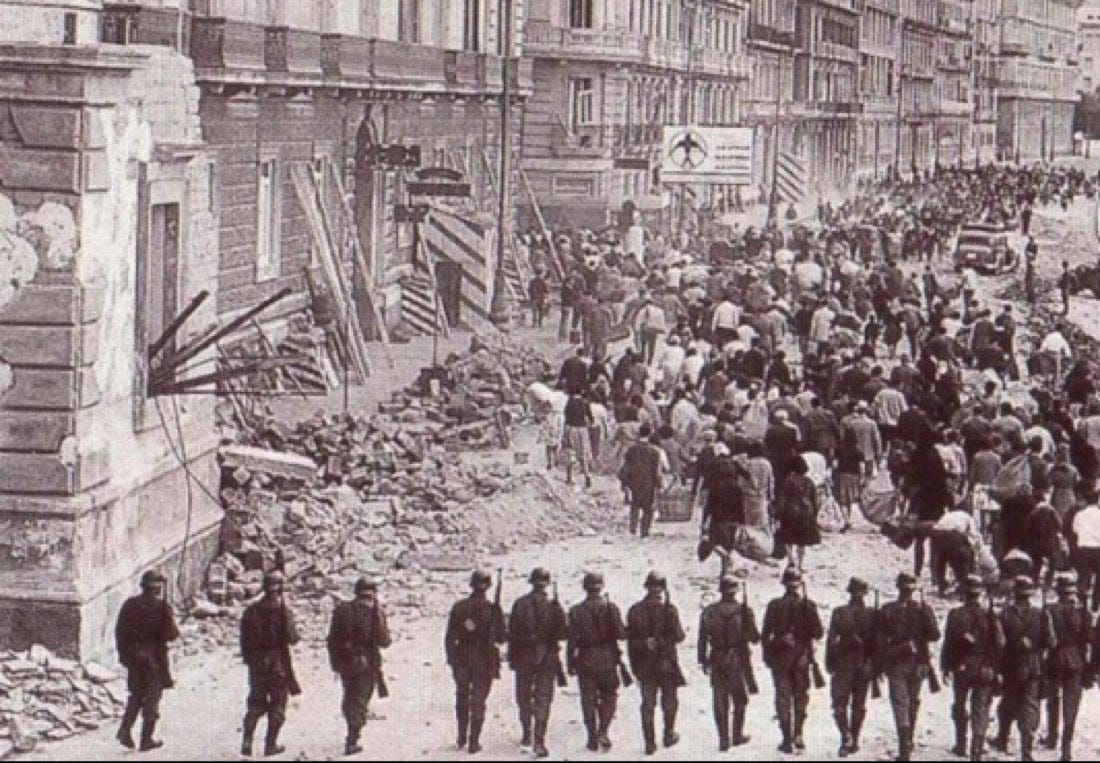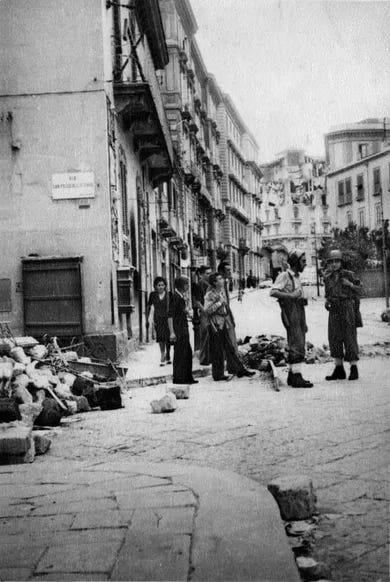Herewith your free weekly round up of everything history-like that I have been up to…
On the Road
I spent most of this week finishing off our ‘Roads to Rome’ tour. Here are some photos from the day we spent in and around Cassino…
We started off by exploring a nearby ghost town, abandoned after it was ravaged by war in 1943-44.
The CWGC cemetery in the shadow of Monte Cassino also includes a memorial to the missing on this front in the Second World War. The American cemetery is some way away at Nettuno, but there are a handful of Americans buried here too.
Not a chance that our group was going to settle for driving past a Sherman…
We also visited the nearby German cemetery…
And the Polish one…
And of course, we visited the rebuilt monastery, which was completely shattered in 1944.
We are in talks with locals about putting on a five day, intensive Monte Cassino tour in 2026. To stay up to date with news on that one, you can join our mailing list by visiting www.istoriatravel.org
Coming Up
You might have missed the opportunity to join us in Italy, but I thought I’d spend a few words telling you more about our Sword Beach tour with Stephen Fisher next year. We’ll be heading out to Normandy from 11th-14th April 2025, and you can expect a packed weekend of content with the one historian who knows more about this aspect of D-Day than anyone… We’ll take in this sector in unparalleled detail, including:
QUEEN, WHITE, RED BEACHES - 4 and FRENCH COMMANDO ATTACK - Coastal Battery - GRAND BUNKER - Lion-sur-Mer - 41 (RM) COMMANDO Hermanville-sur-Mer - Stade du Petit Bonheur - 2 EAST YORKS - Bois du Caprice- STRONGPOINTS 14, 12, WN17 - 1 Suffolk - HERMANVILLE - Periers Ridge - BEAUVILLE - LEBISEY WOOD - CAMBES-EN-PLAINE
For full details or to book your place, click on the image below…
This Week
On Monday I did another film pitch, this time in honour of a woman in revolutionary France who was not afraid to call out Robespierre for cutting everyone’s head off…
The lead character is Olympe de Gouges and she was born in 1748, which made her round about 40 when it all kicked off at the end of the 18th Century in Paris… So think Marion Cotillard in the lead, possibly Kate Winslet, Reese Wetherspoon. Just don’t be doing that thing you do where you cast a 25 year old with firmer boobs and expect us all to buy that she’s menopausal with grown up kids. The whole world will not sh*t the bed. We can handle it.
Olympe has a suitably vague and potentially dramatic origin story that you can play with. She could have been the daughter of anyone from a butcher to Louis XV depending on who you read, so take your pick, no history nerds can call you on it, you won’t get Ridley Scotted. Originally from the southwest of France, she came from a comfortable family who married her off to a caterer at the age of 17 against her will. She’d later write a semi-autobiographical novel called Mémoires de Madame de Valmont, and of this she said: “I was married to a man I did not love and who was neither rich nor well-born. I was sacrificed for no reason that could make up for the repugnance I felt for this man.” He certainly got the better deal, as her money enabled him to start his own business. I suppose then, it was a relief when within a couple of years he died. He possibly drowned, but he apparently just disappears from the record, so potentially you could even have Olympe digging a hole in the garden wearing a ballgown and again, you’re bullet proof. Knock yourselves out. Wherever the inconvenient spouse went, he left her a widow with a baby son, and she was done with husbands, later referring to marriage as “the tomb of trust and love.” She was definitely not done with sex though. She’d just be getting it on her terms now….
When she was 20, a lover paid for Olympe to relocate to Paris and gave her an income, which means you get to show a coach bumping along a country road to a CGI 18th Century Paris skyline with a fanfare in the background. Accompanied by her sister and her son, Olympe built up her life as a socialite, whilst supporting her kid as a single parent, and at one point was referred to as one of the prettiest women in the city. She ran with writers, artists and philosophers, as well as aristocrats and budding politicians. After a number of years, Olympe published a novel of her own in 1784 and then began writing plays.
But none of that is why you need to make a series about her. You need to put her in the limelight because she was utterly incapable of keeping her mouth shut when she saw injustice and maltreatment and it got her into all kinds of trouble.
Finish reading here:
On Thursday I did a photo piece defending Naples. It often gets a bad press…
I’ve heard so many people criticise Naples as a sh*thole. Having taken a group on a WW2 walking tour of the city last week, I wanted to stick up for Napoli. She took an absolute battering at the hands of both Allied and Axis powers during the war, so if you’re wondering where the shiny stuff has got to, or why she might lack a bit of character in places, you can bear this in mind for starters. Here are a few images that highlight what the city and her people endured after the Allied invasion of Italy in September 1943…
At the same time as the invasion, Italy backed out of the war and left Germany in the lurch (take that Hitler). With both American and British landings happening to the south, German troops flooded through Italy. Napoli was occupied, and a 59 year old cavalryman named Walter Scholl was put in charge of the Naples Military Area on 12th September. The city was still home, despite its systematic destruction by Allied bombers, to some half a million people with nowhere else to go, and he began by laying down the law with these orders which were plastered all over the city:
‘Every single citizen who behaves calmly will enjoy my protection. On the other hand, anyone who openly or surreptitiously acts against the German armed forces will be executed. Moreover, the home of the miscreant and its immediate surroundings will be destroyed and reduced to ruins. Every German soldier wounded or murdered will be avenged a hundred times.’
There was going to be a curfew from 8 p.m. to 6 a.m.,
He also announced a state of siege.
All firearms and ammunition were to be handed in. Anyone found in possession of one after twenty-fours had passed would be shot.
His final instruction was that everyone should keep calm and act reasonably.
As if this didn’t make the Germans unpopular enough, they then ordered an entire coastal strip of the city to be evacuated to a depth of 300 metres. The evacuation order caused mayhem as it had to be completed in 24 hours. One witness recorded: 'They flee with tired faces, an absent gaze, bent under the weight of crates and suitcases. Many women cry.’ Unsurprisingly, Neopolitans were pissed off. That and they were emboldened by the news that the Allies were on their way. Take a stroll through Naples and you can’t avoid the phrase ‘Quattro giornate di Napoli,’ the Four Days of Naples. This is a big deal of you are a Neapolitan, and this event is still celebrated annually. You’ll see it claimed as paving the way for the Allied entry to the city, and it certainly made the German situation worse, but here’s a more balanced Italian view:
‘The advance of the Anglo-Americans and the city riots accelerated the reaction of the German military commander in Naples, Colonel Walter Scholl, who declared a state of siege and the desire to execute one hundred Neapolitans for every German killed. Between 27th and 30th September, a series of spontaneous actions in support of the Neapolitan clandestine resistance spread throughout all the neighbourhoods, where harsh clashes took place, attacks on ammunition depots and the liberation of Italian prisoners rounded up by the Germans. The Neapolitans also committed themselves to preventing the devastation planned by the occupiers who were undermining the city's infrastructure and main public buildings, leaving around 300 victims on the ground.’
The clashes varied in size. One of the first incidents occurred in Vomero, where a group of armed men stopped a German car and killed the driver, an NCO. At Porta Capuana, about 40 men armed with rifles and machine guns set up a roadblock and ended up killing six German soldiers, whilst capturing another four. At the other end of the scale 200 insurgents, led by Italian lieutenant, Enzo Stimolo, (the German intention after Italy cutting ties was to disarm the million or so men Italy had under arms, good luck with that) attacked a weapons depot at Castel Sain Elmo and captured it.
On our tour, we visited this spot, the site of a barricade during the German occupation put up by locals.
You can finish reading here:
Next week
Stay tuned for the second part of my Feature on the war service of RMS Queen Mary, and there will also be a tribute to an Italian First World War hero who happens to have fought despite having only one leg…
















